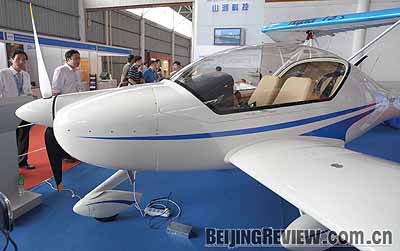|
|
 |
|
PRIVATE BOOM: Some of China’s private enterprises have made a rush into hi-tech industries, such as Hunan Sanhe Science and Technology Holdings Co. Ltd., which manufactures small aircraft (LU HANXIN) | China’s employment landscape looks sparse right now as many private enterprises that absorb much of the country’s workforce are succumbing to economic stagnation. While the Western world is caught in a tailspin, numerous private enterprises, and exporters in particular, have no place to hide. Their orders are declining to a trickle, and the supply chains of many also have broken down because of a lack of cash. In such a time of gloom, how can they weather the storm through innovation and industrial upgrading? Beijing Review reporter Hu Yue interviewed several economists and entrepreneurs about this issue at the 2008 Dialogue Between Chinese Private Enterprises and Global Fortune 500 held last December in Wenzhou, Zhejiang Province.
Innovation is the key
Wang Zhentao (President of Aokang Group Co. Ltd., a Wenzhou-based shoemaker): The financial storm is indeed a catalyst, but not necessarily a culprit of the predicament confronting many private enterprises. In my point of view, their current woes are largely of their own making, although the currency appreciation and cost inflation have also played a role.
Lax corporate governance leaves China’s private enterprises subject to market fluctuations and downside risks. Severe technology and talent bottlenecks choke their potential for sustainable growth. Moreover, the credit tightening had also dried up the financing that the firms depend on for trade and manufacturing. When competition intensifies, their survival is usually staked on a vicious price war.
But the market windup is of no merit as it picks losers and winners. It squeezes some out of the market and forces more to examine their business models. While the export downturn takes some shine off the outdated labor-intensive business model, innovation and industrial upgrading have come into focus for creating more value for enterprises. It’s time now for private enterprises to join forces in weathering the storm and draw some strength from self-restructuring and innovation.
Not a one-off deal
Ma Junru (former Director of the State Administration of Foreign Experts Affairs): It’s already a prevailing trend for multinationals to integrate global innovative resources, including hi-tech, creative management codes and branding strategies. A couple of countries have gained an upper hand in innovative activities; for example, Finland and South Korea. Despite scarce natural resources, their hi-tech products have secured a solid global foothold.
But China’s industrial upgrading and innovation cannot be a one-off deal, but a prolonged drive that entails persistent efforts. The industries should push ahead with their innovative endeavors in a step-by-step manner in line with their realities.
Rushing to so-called hi-tech industries by administrative orders would just leave more unintended subsequent consequences, such as massive layoffs. Private enterprises, therefore, should be given a longer transitional period to phase in adequate hi-tech and modern business models that fit with their status quo and long-term targets.
As a result, the country’s industrial restructuring drive also calls for a soft landing, as the real economy does, so that enterprises can grow more steadily and healthily.
Charles Wu (Vice President of IBM Corp., Greater China Region): Innovation can be an invention that comes up with a brand-new product or a switch in business model from manufacturing to catering. But whatever kind it is, it should be able to bring more value for the enterprises and strengthen their core competitiveness.
The truly helpful innovation we are expecting does not have to include a sensational invention or a big change in business model. As long as it could help the enterprises increase their value-added products and move up along the global value chain, it is worth our efforts.
After all, domestic private enterprises should take a gradual approach to innovation-first spot their core competitiveness in some basic fields such as risk control and corporate governance, and then maximize their core competitiveness on a global level through innovative activities.
Industrial design
Dennis Simon (a business professor at Pennsylvania State University): Global multinationals and private enterprises have become increasingly aware of the pivotal role that industrial design plays in product innovation. As a general concept for packaging and branding, industrial design can continuously refresh a product’s image and also help sharpen its competitive edge. Private enterprises, in particular, are supposed to march ahead with efforts to upgrade their industrial designs in step with their industrial innovations. Otherwise their customer bases may hit rocks amid fierce market competition.
| 